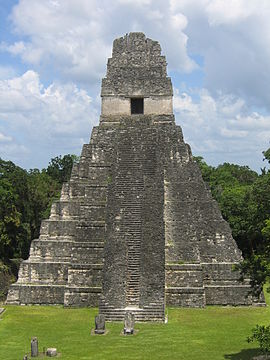Tikal National Park
This article includes a list of general references, but it lacks sufficient corresponding inline citations. (October 2022) |
| UNESCO World Heritage Site | |
|---|---|
 Tikal Temple I rises 47 meters (154 ft) high.[1] | |
| Official name | Tikal National Park |
| Location | |
| Criteria | i, iii, iv, ix, x |
| Reference | 64 |
| Inscription | 1979 (3rd Session) |
| Coordinates | 17°13′19″N 89°37′25″W / 17.22194°N 89.62361°W |
Tikal National Park is a national park located in Guatemala, in the northern region of the Petén Department. Stretching across 57,600 hectares (220 sq mi), it contains the ancient Mayan city of Tikal and the surrounding tropical forests, savannas, and wetlands.[2] In 1979, Tikal National Park was declared as a World Heritage Site by UNESCO, because of the outstanding Mesoamerican ruins at Tikal and the unique ecology of the surrounding landscape.[2]
History
[edit]"Project Tikal", as it was named at the time, was first proposed by the University of Pennsylvania in 1949.[3] Founded on May 26, 1955, Tikal National Park was established under government decree by the Ministry of Education, via the Instituto de Antropología e Historia, advised by Dr. Adolfo Molina Orantes and under the government of Carlos Castillo Armas.[4][5][2] Once established, the University of Pennsylvania played a role in the park's cleaning, maintenance, excavation and restoration of the site from 1956 to 1969.[3]
Today, Tikal National Park's main tourist attraction is the classical, Mayan city Tikal, which is surrounded by a dense, lush forest.
Ecology
[edit]Tikal National Park makes up part of the global Man and the Biosphere Programme, within the Maya Biosphere Reserve.[6] Because of its lush and varied ecosystem, many species of plants and animals thrive within the park boundaries. Five species of cats reside within the park, including the jaguar and puma, along with several species of monkeys and anteaters.[2] In addition, more than 300 species of birds are found in the park, including the crane hawk and the ocellated turkey.[7]
References
[edit]- ^ Martin, Simon; Nikolai Grube (2000). Chronicle of the Maya Kings and Queens: Deciphering the Dynasties of the Ancient Maya. London and New York: Thames & Hudson. p. 47. ISBN 978-0-500-05103-0. OCLC 47358325.
- ^ Jump up to: a b c d "Tikal National Park". UNESCO World Heritage Convention. United Nations Educational Scientific and Cultural Organization. Retrieved 10 December 2022.
- ^ Jump up to: a b Rainey, Froelich. "Tikal, A 14 Year Program Now Completed by Penn Museum Expedition Magazine, Winter 1970". Penn Museum Expedition Magazine. Retrieved 6 October 2022.
- ^ Ministry of Culture and Sports of Guatemala. "Tikal Government Page". Guatemala. Retrieved 6 October 2022.
- ^ Torres, Estuardo. "Parque Nacional Tikal" (in Spanish). Ministerio de Cultura y Deportes. Archived from the original on 18 December 2009. Retrieved 30 July 2014.
- ^ UNESCO (25 June 2019). "UNESCO Maya Biosphere Reserve, Guatemala". UNESCO. Retrieved 6 October 2022.
- ^ Sutter, Jason; Martínez A., Walter E.; Oliva T, Francisco; Oswaldo J, Nery; Whitacre, David F. (1 February 2001). "Diet and Hunting Behavior of the Crane Hawk in Tikal National Park, Guatemala". The Condor. 103 (1): 70–77. doi:10.1093/condor/103.1.70.
- Martin, Simon; Nikolai Grube (2008). Chronicle of the Maya Kings and Queens: Deciphering the Dynasties of the Ancient Maya (2nd revised ed.). London and New York: Thames & Hudson. ISBN 978-0-500-28726-2. OCLC 191753193.
- Ponciano, Erick M. "Decreto Legislativo 425 de 1947, Ley Sobre Protección y Conservaciónde los Monumentos, Objetos Arqueológicos, Históricos y Típicos" (PDF). Asociación Tikal. Retrieved 6 October 2022.
- Ponciano, Erick M. "Acuerdo de Creación del Parque Nacional Tikal" (PDF). Asociación Tikal. Retrieved 6 October 2022.
External links
[edit]- Guatemalan Government Official Site for Tikal, Ministry of Culture and Sports of Guatemala (in Spanish)
- Aproximación a la conservación arqueológica en Guatemala, Asociación Tikal (in Spanish)

